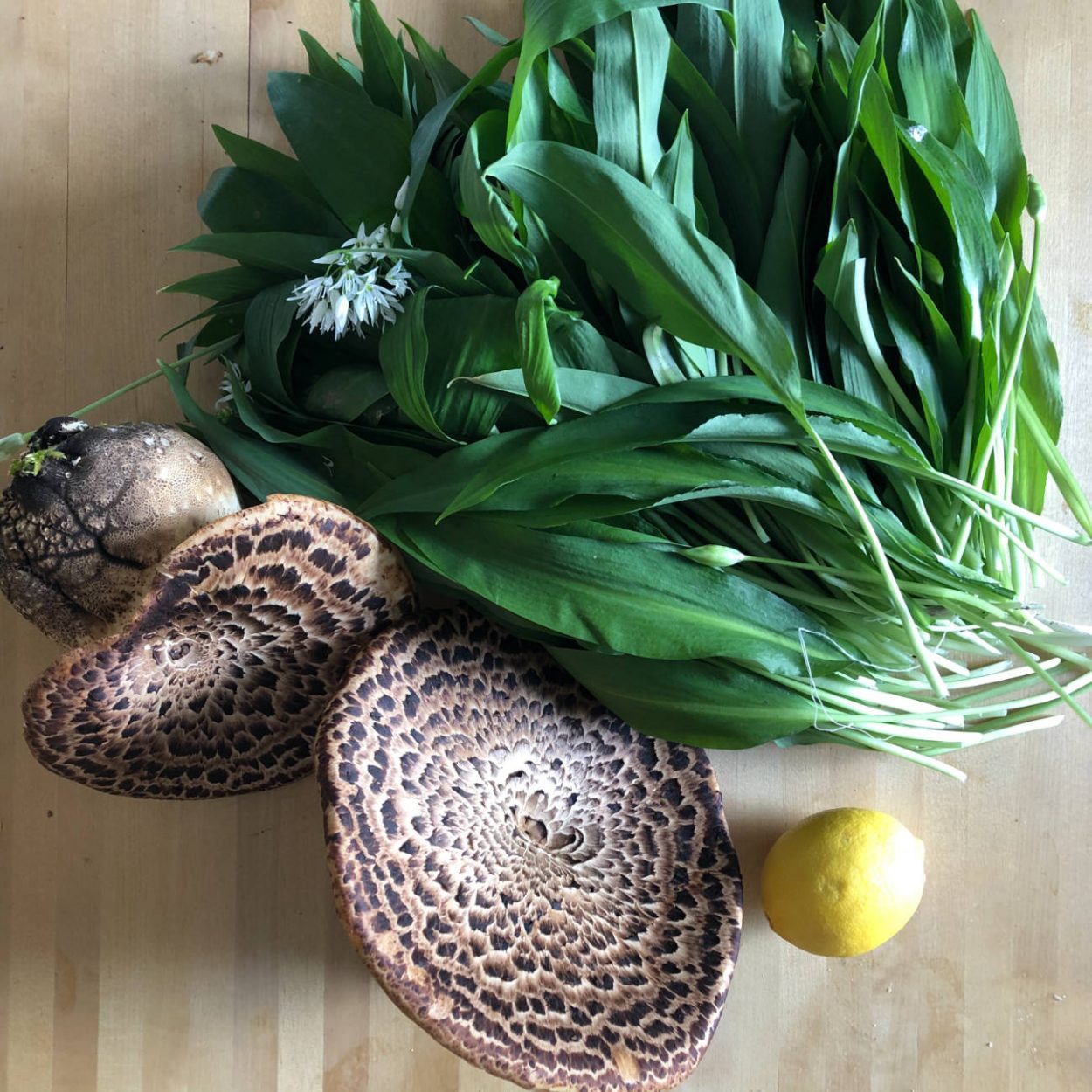I was away recently for a lovely weekend with a big group of 16 people. Dinner on the last night was a use-up-all-the-things meal that I tag-teamed with BW. This is a rough description of each thing, a bunch of them were new to me but I’d like to make them again. We were super low on olive oil so went heavy on the butter, and we omitted garlic + onions in most things due to some dietary restrictions within the group.
Cheese
Use a peeler to get thin slices off any nearly-finished firm cheese in the fridge. Pile the slices together on a plate, then throw the rind in to the fridge or freezer for use in future stews or pots of lentils / beans.
Arbutus (strawberry tree) jam
Good with cheese. This was sort of based on a variety of recipes online. I didn’t mind the texture but it was probably a bit too seedy for most TBH, so next time I’d probably strain part way through cooking while the mixture is still relatively liquid.
Remove stems and bad bits from about 2 cups of ripe Arbutus (strawberry tree) berries, then rinse and put in a small nonstick pot. Cut an orange in to chunks and squeeze in the juice, then throw in the rind. Cut a lemon in half and squeeze in the juice of a lemon half, then throw in the rind. Add about ¼ cup sugar and a small pinch of salt, and then simmer over medium-low heat until the berries are completely dissolved. Add water during the cooking process if needed, and taste while cooking to adjust the sweetness. Remove the citrus rinds before serving. The colour of the cooked jam should be a reddish ochre, and the consistency is similar to fig jam, very seedy.
Lamb’s lettuce salad
In an enormous bowl, combine a big pile of Lamb’s lettuce with soft, crumbled fresh cheese, a chopped avocado, a big handful of chopped black olives, the sliced green tops from 3–4 scallions, and a very big handful of toasted pine nuts.
For the dressing, combine olive oil, some red wine vinegar, lemon juice, honey, a mashed anchovy, salt, and fresh black pepper. Taste the dressing and adjust it to balance it out, then add it to the salad and toss to coat.
Croutons
This was probably the biggest experiment. I’ve done this with cubed bread of all sorts in the past, but never GF bread. Specifically, we used leftover GF focaccia which had been made from leftover pizza dough and topped with capers, olives, rosemary, and tomatoes. It was pretty firm due to the GF flour, sort of the consistency of cornbread crossed with polenta. The resulting croutons were maybe a bit too big / crunchy for a salad but still very tasty, kind of like baked polenta. It actually worked pretty well with this meal since most of the other things lacked crunch.
Preheat the oven to about 200C. Cube a bunch of leftover firm bread, then toss it in butter or oil and season to taste with salt and spices or herbs. Roast in the oven until golden and crispy.
Puy lentils with rosemary and thyme
I definitely over-salted these! Still good though. Every other time I’ve made Puy lentils they’ve come out way too bland, so I’ll probably make them like this in the future, probably with a bay leaf and maybe some other herbs. I’d be a great side to make instead of potatoes or rice, for example.
Pour a 500 g box of lentils de Puy in to a medium sized pot with enough water (see the instructions on the box), the rind of a hard cheese, a good pinch of salt, a knob of butter, fresh black pepper, and about 2 tablespoons each of chopped thyme and rosemary. Bring to a boil and simmer until the lentils are tender and the water is mostly gone. Note that you may need to top up the water during cooking. When nearing the end of cooking, taste the lentils and adjust the flavours. Add a little salt, lemon juice, and / or orange juice to adjust the flavour and acidity. Remove and discard the cheese rind before serving.
Caramelised onions
Ours weren’t quite caramelised, but still tasty! Apparently sodium bicarbonate is a useful secret ingredient if you’re light on time, need to remember that for next time.
Thinly slice 4 onions and place in wide, flat-ish pot. Stainless steel or aluminium is best if you have a lot of time, nonstick works well if you don’t. Add a pinch of salt and a knob of butter, then cook over medium-low heat until a deep golden brown.
Roasted aubergines
These are good lukewarm or cold as well. Do not be tempted to season with salt before sticking them in the oven, there will be plenty in the veg still from the initial step.
Preheat the oven to about 200C. Slice aubergines in to rounds that are roughly 1 cm thick, then salt on both sides and place in a shallow dish. Allow the salt to draw out the water for at least 15 minutes, pressing on them occasionally to encourage them. Once a lot of the water has been drawn out, put the aubergine slices in a big bowl of cold water and rinse thoroughly, removing all of the remaining salt. Squeeze the water out of the slices, then place in a baking dish. Top each slice with a little butter or olive oil, generously top with fresh black pepper, then sprinkle over about 1–2 tablespoons each of chopped thyme and rosemary. Roast in the oven for 30–40 minutes, turning halfway. Taste when done and add a squeeze of lemon juice if desired.
Pasta with tomato sauce, basil, and anchovies
BW tackled this mostly, so here’s hoping I’ve remembered this correctly! She said it was based on a Rachel Roddy recipe so I had a look online. Her recipe for pasta with tomatoes and anchovy sauce looks really similar and very good, though I don’t think it’s the same one. Worth a try!
Heat some butter or olive oil in a large flat-ish pan, then add halved baby tomatoes and cook until very soft. Add two finely chopped anchovies and cook a little longer, then add one chopped stove-roasted red pepper and a can of chopped tomatoes. Allow the sauce to simmer and reduce while you cook the pasta. Cook the pasta of your preference in heavily salted water until al dente and then drain, reserving a small amount of the pasta water in the pot. Tip the sauce in to the pasta and reserved pasta water and then cook a little longer, allowing the water to reduce slightly and the pasta to finish cooking. Stir in a whole bunch of torn basil and serve.
Spiced roasted carrots + broccoli
Kind of based on the honey roasted carrots from this Guardian article. Try to avoid crowding the pan or cooking too much at once in the oven because it will inhibit roasting and will cause the veg to steam. If you have to cook a lot at once, consider cranking up the heat.
Preheat the oven to about 200C. Put a bunch of oblique / roll cut carrots in to a big baking dish with the florets and peeled stem of a head of broccoli. Add a very generous sprinkling of brown sugar, a good pinch of salt, a squeeze of lemon juice, some lemon zest, a lot of cumin seed, about a thumb’s worth of minced ginger, and about 1–2 teaspoons of ground coriander. Roast until the edges are well browned, tossing occasionally to cook evenly.
Spiced chickpeas and greens
The vibe was espinacas con garbanzos, but with what we had on hand. I would definitely consider adding some cayenne, smoked paprika, garlic, etc. in other circumstances. For the greens we used rocket and spinach, but this would probably be good with kale as well though the cook time would take a little longer.
Heat a knob of butter in a large pan over medium-high heat, then pour in a can of chickpeas, drained. Add a very good pinch of salt, at least 2 tablespoons of cumin seed, 1–2 tablespoons of ground coriander, and a solid pinch of ground cinnamon. Cook for about 5 minutes to allow the flavours to come together, then your greens and the juice from at least a half an orange. Allow the greens to cook to the desired doneness, adding water if needed. Taste and adjust flavours as necessary (salt, lemon, etc.).
Roasted potatoes with a roasted pepper sauce
The idea was sort of patatas bravas, but again, with what we had on hand. Would probably consider smoked paprika, cayenne, garlic for this as well.
Preheat oven very hot, at least 200C. Cut 5–6 thin-skinned potatoes in to chunks and parboil, then toss in to a baking pan with oil and season with salt and pepper. Roast in the oven until brown and crispy. For the sauce, reduce a can of chopped tomatoes over medium heat, then add a knob of butter, some cumin seed, and one finely chopped stove-roasted red pepper.





